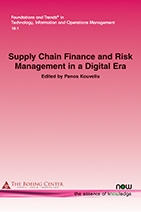Value of Reverse Factoring under Make-to-Order Production Environments
By Fehmi Tanrisever, Bilkent University, Turkey, tanrisever@bilkent.edu.tr | Matthew Reindorp, Drexel University, USA, mjr424@drexel.edu | Hande Cetinay, Eindhoven University of Technology, The Netherlands, handecetinay@gmail.com | Jan C. Fransoo, Tilburg University, The Netherlands, jan.fransoo@tilburguniversity.edu
Abstract
Reverse factoring has received significant attention as a means for small and medium-sized firms to access capital. In this monograph, we explain the value creation mechanism of reverse factoring and derive the value of reverse factoring contracts for firms in make-to-order (MTO) production environments. Empirical and other theoretical work on reverse factoring exists in research literature, but our model constitutes the first analytic treatment of the problem for a pure MTO setting. We show how the value of reverse factoring results from and is conditioned by (1) the spread in deadweight external financing costs, (2) payment period extensions, (3) volatility in cash flows, (4) working capital policy, and (5) the risk-free interest rate. Thus, in addition to providing managerial insights on value reverse factoring contracts, our findings disclose an important relation of these elements to the broader macroeconomic context.
Supply Chain Finance and Risk Management in a Digital Era
This special issue, which surveys the most recent research in integrated risk management for supply chains, is motivated by the success of the 8th “Supply Chain Finance and Risk Management Workshop,” which was held at the Olin Business School of Washington University in St. Louis on May 30 and May 31, 2023. The Editors wanted timelier access to the latest research on supply chain finance and supply chain risk management. It is well-known, that due to review process lead times, articles published in traditional journals can take 2 to 3 years. The idea of producing an edited volume, which would include the latest articles on the topics above appealed not only to the workshop participants but also to other active members of the iFORM (Interface of Finance, Operations, and Risk Management) research community. Foundations and Trends in Technology, Information and Operations Management provides an ideal outlet for such a volume.

Online Appendix | 0200000114-3_app.pdf
This is the article’s accompanying appendix.
Companion
Foundations and Trends® in Technology, Information and Operations Management, Volume 18, Issue 1 Special Issue: Supply Chain Finance and Risk Management in a Digital Era
See the other articles that are also part of this special issue.